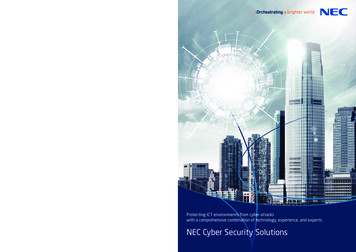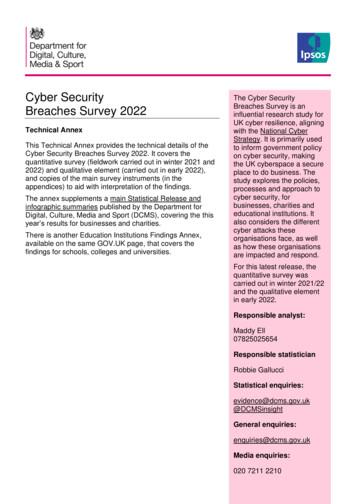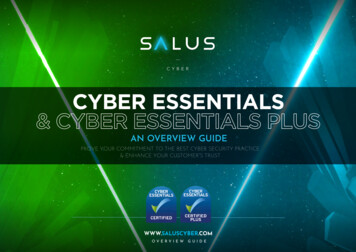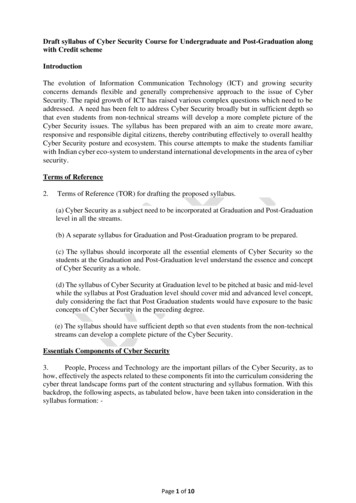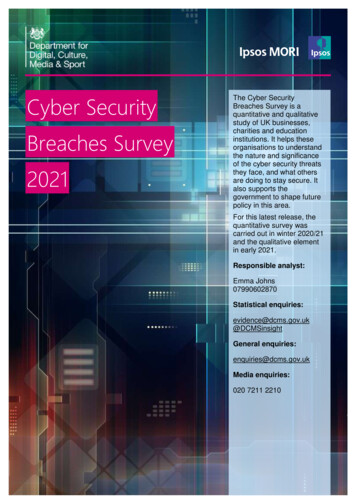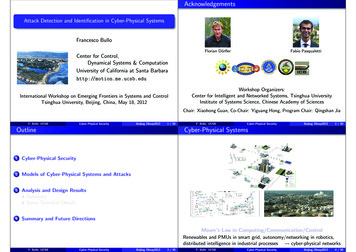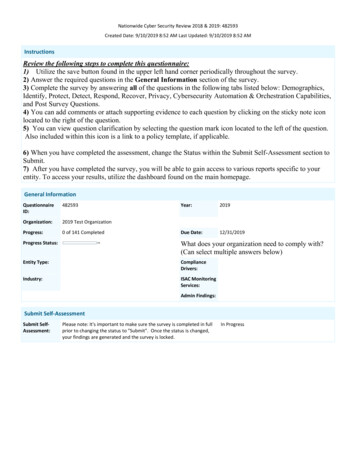
Transcription
Nationwide Cyber Security Review 2018 & 2019: 482593Created Date: 9/10/2019 8:52 AM Last Updated: 9/10/2019 8:52 AMInstructionsReview the following steps to complete this questionnaire:1) Utilize the save button found in the upper left hand corner periodically throughout the survey.2) Answer the required questions in the General Information section of the survey.3) Complete the survey by answering all of the questions in the following tabs listed below: Demographics,Identify, Protect, Detect, Respond, Recover, Privacy, Cybersecurity Automation & Orchestration Capabilities,and Post Survey Questions.4) You can add comments or attach supporting evidence to each question by clicking on the sticky note iconlocated to the right of the question.5) You can view question clarification by selecting the question mark icon located to the left of the question.Also included within this icon is a link to a policy template, if applicable.6) When you have completed the assessment, change the Status within the Submit Self-Assessment section toSubmit.7) After you have completed the survey, you will be able to gain access to various reports specific to yourentity. To access your results, utilize the dashboard found on the main homepage.General InformationQuestionnaireID:482593Organization:2019 Test OrganizationProgress:0 of 141 CompletedYear:2019Due Date:12/31/2019Progress Status:What does your organization need to comply with?(Can select multiple answers below)Entity Type:ComplianceDrivers:Industry:ISAC MonitoringServices:Admin Findings:Submit Self-AssessmentSubmit SelfAssessment:Please note: It's important to make sure the survey is completed in fullprior to changing the status to "Submit". Once the status is changed,your findings are generated and the survey is locked.In Progress
Maturity ScaleThe Nationwide Cyber Security Review utilizes the below response scale which allows participants to indicatehow formalized the cybersecurity activities are within their organization.Optimized: Your organization has formally documented policies, standards, and procedures. Implementationis tested, verified, and reviewed regularly to ensure continued effectiveness.Tested and Verified: Your organization has formally documented policies. standards, and procedures.Implementation is tested and verified.Implementation in Process: Your organization has formally documented policies, standards, and proceduresand are in the process of implementation.Risk Formally Accepted: Your organization has chosen not to implement based on a risk assessment.Partially Documented Standards and/or Procedures: Your organization has a formal policy in place andbegan the process of developing documented standards and/or procedures to support the policy.Documented Policy: Your organization has a formal policy in place.Informally Performed: Activities and processes may be substantially performed and technologies may beavailable to achieve this objective, but they are undocumented and/or not formally approved by management.Not Performed: Activities, processes and technologies are not in place to achieve the referenced objective.Completion TrackingCompletionTracking (ID):0%CompletionTracking (RC):0%CompletionTracking (PR):0%CompletionTracking (PC):0%CompletionTracking (DE):0%CompletionTracking (PostSurvey):0%CompletionTracking (RS):0%
Demographics(CSF) Demographics(NCSR)Demo 1:CybersecurityGovernance:How would you categorize your cybersecurity governance structure?(NCSR)Demo 2:CybersecurityGovernance:How would you categorize your cybersecurity implementation andoperations?(NCSR)Demo 3:CybersecurityGovernance:Who are you answering the NCSR on behalf of?(NCSR)Demo 4:ExecutiveReporting:Do your top-level decision-makers receive periodic (at least annual)reports on the status of information risks, controls, and/or security fromthe departments, divisions, and/or agencies within your organization?(NCSR)Demo 5:Cyber SecurityExecutiveMandates:Has your organization adopted or established a set of cybersecurityexecutive mandates, laws, statutes, approved legislation, policies, orstandards to help guide the implementation of information securitycontrols across your organization?(NCSR)Demo 6:SecurityFramework:Which control frameworks and/or security methodologies are yourorganization's information security controls based on? Select all thatapply.(NCSR)Demo 7:FTE Size:How many full-time equivalent (FTEs) employees/contractors are therein your organization?(NCSR)Demo 8:IT FTE:How many full-time equivalent employees are there in your IT?(NCSR)Demo 9:Security FTE:How many full-time equivalent employees have security related duties?(NCSR)Demo 10: What part of your IT operation is outsourced?IT Outsourcing:(NCSR)Demo 11: What part of your security operation is outsourced?SecurityOutsourcing:Identify
(CSF) Identify.Asset ManagementID.AM-1:Physical devices and systems within the organization are inventoried.ID.AM-2:Software platforms and applications within the organization areinventoriedID.AM-3:Organizational communication and data flows are mappedID.AM-4:External information systems are cataloguedID.AM-5:Resources (e.g., hardware, devices, data, time, and software) areprioritized based on their classification, criticality, and business valueID.AM-6:Cybersecurity roles and responsibilities for the entire workforce andthird-party stakeholders (e.g., suppliers, customers, partners) areestablished(CSF) Identify.Business EnvironmentID.BE-1:The organization’s role in the supply chain is identified andcommunicatedID.BE-2:The organization’s place in critical infrastructure and its industry sectoris identified and communicatedID.BE-3:Priorities for organizational mission, objectives, and activities areestablished and communicatedID.BE-4:Dependencies and critical functions for delivery of critical services areestablishedID.BE-5:Resilience requirements to support delivery of critical services areestablished for all operating states (e.g. under duress/attack, duringrecovery, normal operations)(CSF) Identify.GovernanceID.GV-1:Organizational cybersecurity policy is established and communicatedID.GV-2:Cybersecurity roles and responsibilities are coordinated and alignedwith internal roles and external partnersID.GV-3:Legal and regulatory requirements regarding cybersecurity, includingprivacy and civil liberties obligations, are understood and managedID.GV-4:Governance and risk management processes address cybersecurity risks
(CSF) Identify.Risk AssessmentID.RA-1:Asset vulnerabilities are identified and documentedID.RA-2:Cyber threat intelligence and vulnerability information is received frominformation sharing forums and sourcesID.RA-3:Threats, both internal and external, are identified and documentedID.RA-4:Potential business impacts and likelihoods are identifiedID.RA-5:Threats, vulnerabilities, likelihoods, and impacts are used to determineriskID.RA-6:Risk responses are identified and prioritized(CSF) Identify.Risk Management StrategyID.RM-1:Risk management processes are established, managed, and agreed to byorganizational stakeholdersID.RM-2:Organizational risk tolerance is determined and clearly expressedID.RM-3:The organization’s determination of risk tolerance is informed by its rolein critical infrastructure and sector specific risk analysis(CSF) Identify.Supply Chain Risk ManagementID.SC-1:Cyber supply chain risk management processes are identified,established, assessed, managed, and agreed to by organizationalstakeholdersID.SC-2:Suppliers and third party partners of information systems, components,and services are identified, prioritized, and assessed using a cybersupply chain risk assessment processID.SC-3:Contracts with suppliers and third-party partners are used to implementappropriate measures designed to meet the objectives of anorganization’s cybersecurity program and Cyber Supply Chain RiskManagement Plan.ID.SC-4:Suppliers and third-party partners are routinely assessed using audits,test results, or other forms of evaluations to confirm they are meetingtheir contractual obligations.ID.SC-5:Response and recovery planning and testing are conducted withsuppliers and third-party providersProtect
(CSF) Protect.Access ControlPR.AC-1:Identities and credentials are issued, managed, verified, revoked, andaudited for authorized devices, users, and processesPR.AC-2:Physical access to assets is managed and protectedPR.AC-3:Remote access is managedPR.AC-4:Access permissions and authorizations are managed, incorporating theprinciples of least privilege and separation of dutiesPR.AC-5:Network integrity is protected (e.g., network segregation, networksegmentation)PR.AC-6:Identities are proofed and bound to credentials and asserted ininteractionsPR.AC-7:Users, devices, and other assets are authenticated (e.g., single-factor,multifactor) commensurate with the risk of the transaction (e.g.,individuals’ security and privacy risks and other organizational risks)(CSF) Protect.Awareness and TrainingPR.AT-1:All users are informed and trainedPR.AT-2:Privileged users understand roles & responsibilitiesPR.AT-3:Third-party stakeholders (e.g., suppliers, customers, partners)understand roles & responsibilitiesPR.AT-4:Senior executives understand roles & responsibilitiesPR.AT-5:Physical and cybersecurity personnel understand their roles andresponsibilities(CSF) Protect.Data SecurityPR.DS-1:Data-at-rest is protectedPR.DS-2:Data-in-transit is protectedPR.DS-3:Assets are formally managed throughout removal, transfers, anddispositionPR.DS-4:Adequate capacity to ensure availability is maintainedPR.DS-5:Protections against data leaks are implementedPR.DS-6:Integrity checking mechanisms are used to verify software, firmware,and information integrityPR.DS-7:The development and testing environment(s) are separate from theproduction environmentPR.DS-8:Integrity checking mechanisms are used to verify hardware integrity
(CSF) Protect.Information Protection Process and ProceduresPR.IP-1:A baseline configuration of information technology/industrial controlsystems is created and maintained incorporating security principles (e.g.concept of least functionality)PR.IP-2:A System Development Life Cycle to manage systems is implementedPR.IP-3:Configuration change control processes are in placePR.IP-4:Backups of information are conducted, maintained, and testedPR.IP-5:Policy and regulations regarding the physical operating environment fororganizational assets are metPR.IP-6:Data is destroyed according to policyPR.IP-7:Protection processes are improvedPR.IP-8:Effectiveness of protection technologies is sharedPR.IP-9:Response plans (Incident Response and Business Continuity) andrecovery plans (Incident Recovery and Disaster Recovery) are in placeand managedPR.IP-10:Response and recovery plans are testedPR.IP-11:Cybersecurity is included in human resources practices (e.g.,deprovisioning, personnel screening)PR.IP-12:A vulnerability management plan is developed and implemented(CSF) Protect.MaintenancePR.MA-1:Maintenance and repair of organizational assets are performed andlogged, with approved and controlled toolsPR.MA-2:Remote maintenance of organizational assets is approved, logged, andperformed in a manner that prevents unauthorized access(CSF) Protect.Protective TechnologyPR.PT-1:Audit/log records are determined, documented, implemented, andreviewed in accordance with policyPR.PT-2:Removable media is protected and its use restricted according to policyPR.PT-3:The principle of least functionality is incorporated by configuringsystems to provide only essential capabilitiesPR.PT-4:Communications and control networks are protectedPR.PT-5:Mechanisms (e.g., failsafe, load balancing, hot swap) are implementedto achieve resilience requirements in normal and adverse situations
Detect(CSF) Detect.Anomalies and EventsDE.AE-1:A baseline of network operations and expected data flows for users andsystems is established and managedDE.AE-2:Detected events are analyzed to understand attack targets and methodsDE.AE-3:Event data are collected and correlated from multiple sources andsensorsDE.AE-4:Impact of events is determinedDE.AE-5:Incident alert thresholds are established(CSF) Detect.Security Continuous MonitoringDE.CM-1:The network is monitored to detect potential cybersecurity eventsDE.CM-2:The physical environment is monitored to detect potential cybersecurityeventsDE.CM-3:Personnel activity is monitored to detect potential cybersecurity eventsDE.CM-4:Malicious code is detectedDE.CM-5:Unauthorized mobile code is detectedDE.CM-6:External service provider activity is monitored to detect potentialcybersecurity eventsDE.CM-7:Monitoring for unauthorized personnel, connections, devices, andsoftware is performedDE.CM-8:Vulnerability scans are performed(CSF) Detect.Detection ProcessDE.DP-1:Roles and responsibilities for detection are well defined to ensureaccountabilityDE.DP-2:Detection activities comply with all applicable requirementsDE.DP-3:Detection processes are testedDE.DP-4:Event detection information is communicatedDE.DP-5:Detection processes are continuously improved
Respond(CSF) Respond.Response PlanningRS.RP-1:Response plan is executed during or after an event(CSF) Respond.CommunicationsRS.CO-1:Personnel know their roles and order of operations when a response isneededRS.CO-2:Incidents are reported consistent with established criteriaRS.CO-3:Information is shared consistent with response plansRS.CO-4:Coordination with stakeholders occurs consistent with response plansRS.CO-5:Voluntary information sharing occurs with external stakeholders toachieve broader cybersecurity situational awareness(CSF) Respond.AnalysisRS.AN-1:Notifications from detection systems are investigatedRS.AN-2:The impact of the incident is understoodRS.AN-3:Forensics are performedRS.AN-4:Incidents are categorized consistent with response plansRS.AN-5:Processes are established to receive, analyze and respond tovulnerabilities disclosed to the organization from internal and externalsources (e.g. internal testing, security bulletins, or security researchers)(CSF) Respond.MitigationRS.MI-1:Incidents are containedRS.MI-2:Incidents are mitigatedRS.MI-3:Newly identified vulnerabilities are mitigated or documented asaccepted risks(CSF) Respond.ImprovementsRS.IM-1:Response plans incorporate lessons learnedRS.IM-2:Response strategies are updated
Recover(CSF) Recover.Recovery PlanningRC.RP-1:Recovery plan is executed during or after a cybersecurity incident(CSF) Recover.ImprovementsRC.IM-1:Recovery plans incorporate lessons learnedRC.IM-2:Recovery strategies are updated(CSF) Recover.CommunicationsRC.CO-1:Public relations are managedRC.CO-2:Reputation is repaired after an incidentRC.CO-3:Recovery activities are communicated to internal and externalstakeholders as well as executive and management teamsPrivacyPrivacyPC - 1:Does your organization have a privacy officer?PC - 2:Does your organization have clearly defined processes to report abreach of PII/PHI?
Cybersecurity Automation & Orchestration CapabilitiesCybersecurity Automation & Orchestration(Automation)Question 1:Security Information and Event Management (SIEM) tools are fullyimplemented, monitored, and managed.(Automation)Question 2:Identity and Access Management (IAM) tools are fully implemented,monitored, and managed.(Automation)Question 3:Two factor authentication has been fully implemented.(Automation)Question 4:Mobile Device Management (MDM) tools are fully implemented for theadministration of mobile devices.(Automation)Question 5:Vulnerability assessment tools are fully implemented, monitored, andmanaged.(Automation)Question 6:Intrusion Defense System (IDS) tools are fully implemented.(Automation)Question 7:Intrusion Prevention System (IPS) tools are fully implemented.(Automation)Question 8:End point protection tools are fully implemented to monitor andanalyze network endpoints.(Automation)Question 9:Automated tools are used to manage physical IT assets (i.e., inventoryand tracking of all software or hardware within an IT environment).(Automation)Question 10:Automated tools are used to manage and control removable media.(Automation)Question 11:Automated tools are used to encrypt sensitive data in transit betweennetworks.(Automation)Question 12:Automated tools are used to create and maintain baselineconfiguration/change control information.(Automation)Question 13:Automated tools are used to conduct and test system backups.(Automation)Question 14:Penetration tests are performed to exploit identified vulnerabilities.(Automation)Question 15:Antiviral tools are implemented, monitored, and managed.(Automation)Question 16:Automated methods are used to integrate disparate security systems.Post Survey QuestionsGeneral(Post Survey)Question 1:What are your top 5 security concerns?(Post Survey)Question 2:Were you able to answer all of the assessment questions?(Post Survey)Question 3:How long did it take you to complete this assessment (including timespent researching answers off-line)(Post Survey)Question 4:Are you completing the 2019 NCSR to meet the Homeland SecurityGrant Program (HGSP) requirement?
History LogView History LogCommentsQuestion NameNo Records FoundSubmitterDateCommentAttachment
organization's cybersecurity program and Cyber Supply Chain Risk Management Plan. ID.SC-3: Suppliers and third party partners of information systems, components, and services are identified, prioritized, and assessed using a cyber supply chain risk assessment process ID.SC-2: Cyber supply chain risk management processes are identified,



